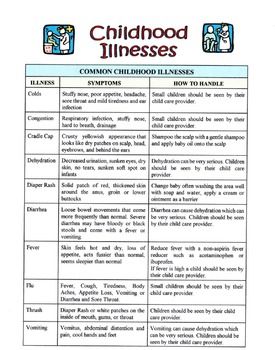In every child's life, there comes a time when they fall ill. It's an unfortunate part of growing up, but thankfully, most childhood illnesses are not serious and can be easily treated with proper care. In this article, we will explore some of the most common childhood illnesses, their symptoms, and the recommended treatments.
1. Common Cold
The common cold is perhaps the most widespread childhood illness. It is caused by a viral infection and usually lasts for a week to ten days. Symptoms of a common cold include a runny or stuffy nose, cough, sore throat, and mild fever. It is highly contagious and spreads easily in daycare centers and schools.
2. Chickenpox
Chickenpox is a highly contagious viral infection characterized by itchy red rashes that develop into small, fluid-filled blisters. Other symptoms may include fever, headache, and fatigue. Chickenpox can be dangerous in older children or those with weakened immune systems. Vaccination can prevent this illness, and if infected, proper rest, maintaining hygiene, and using lotions to relieve itching are recommended.
3. Ear Infections
Ear infections are common among young children and usually result from a bacterial or viral infection. Symptoms include ear pain, a feeling of fullness in the ear, hearing loss, and fever. Antibiotics are often prescribed to treat bacterial ear infections, while viral ear infections usually resolve on their own. Prevention methods include keeping the ears clean, avoiding second-hand smoke, and breastfeeding infants.
4. Stomach Virus
Stomach viruses, also known as gastroenteritis, cause inflammation of the stomach and intestines. Symptoms include vomiting, diarrhea, stomach cramps, and fever. The viruses responsible for stomach bugs can be easily spread through contaminated food, water, or close contact with an infected person. Adequate fluid intake is crucial to prevent dehydration, while over-the-counter medications can help alleviate symptoms.
5. Bronchitis
Bronchitis is an infection that causes inflammation of the air passages in the lungs. It can be viral or bacterial and is often triggered by respiratory viruses. Symptoms of bronchitis include coughing, wheezing, chest congestion, and difficulty breathing. Rest, staying hydrated, and using a humidifier can help alleviate symptoms. For bacterial bronchitis, a doctor may prescribe antibiotics.
6. Hand, Foot, and Mouth Disease
Hand, Foot, and Mouth Disease (HFMD) is a common childhood viral infection that mainly affects children under 5 years old. It usually causes fever, sore throat, and a rash with blisters on the hands, feet, and mouth. The infection spreads through close personal contact, coughing, or sneezing. There is no specific treatment for HFMD, but over-the-counter medications can help relieve symptoms.
7. Asthma
Asthma is a chronic condition that affects the airways, making it difficult to breathe. It often starts in childhood and can vary in severity. Common symptoms of asthma include wheezing, coughing, shortness of breath, and chest tightness. Asthma triggers can be different for each individual, but common triggers include allergens, exercise, and cold air. Treatment includes inhalers and identifying and avoiding triggers. Childhood illnesses are a part of life, but with proper care and attention, most of them can be managed effectively. It is important to recognize the symptoms and seek appropriate medical advice if needed. With adequate rest, hydration, and sometimes medications, children can recover from these common illnesses and continue to grow and thrive.
